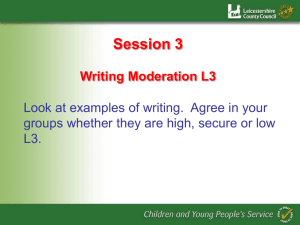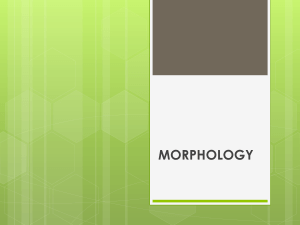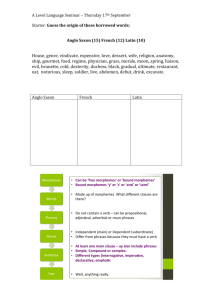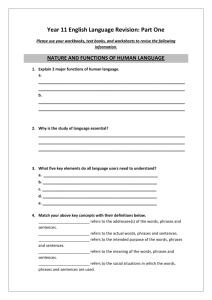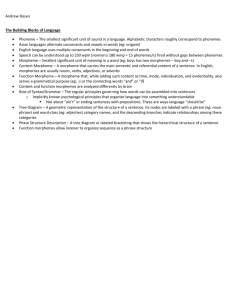Revision - SchoolRack
advertisement
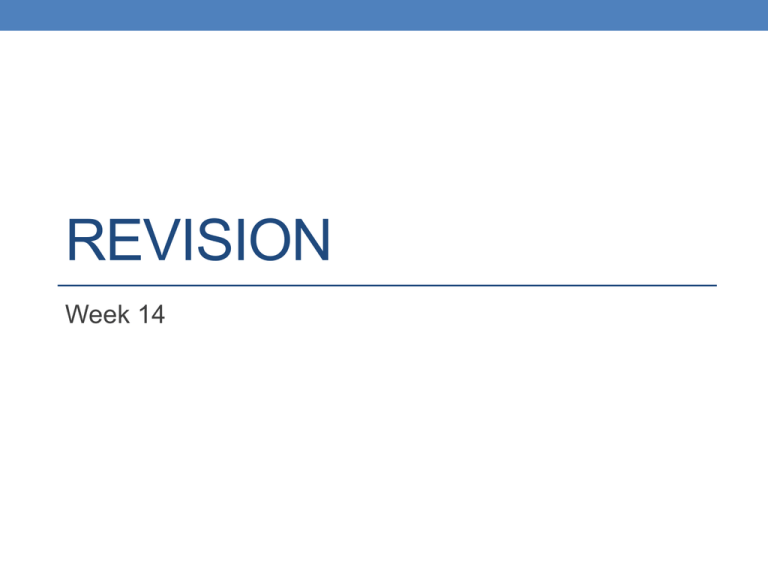
REVISION Week 14 Chapter One What is Language? Linguistic Knowledge When you know a language… Language is much more than speech. How? Deaf people use sing language, and express meaning only the manner and modality is different from spoken language. So…what is the relation between speech sounds and the meaning they represent ? The relationship between form (sound) and meaning (concept) of a word is arbitrary. When someone mentions the word house you will imagine it, and not something else. This is also true in sign language. The creativity of Linguistic knowledge • Knowledge of language enables you to combine sounds to form words, words to form phrase, phrases to form sentences. • Knowledge of language makes it possible to understand and produce new sentences. Linguistic Competence Versus Performance (Chomsky) • Grammatical competence (Unconscious knowledge of possible grammatical structures in an idealized speaker) • *What eats John? • What does John eat? • Performance (Actual production and comprehension of language in specific instances of language use) • Whe..When are you coming? • I don’t… well uhm, maybe tomorrow. 5. Linguistic knowledge and Performance Our linguistic knowledge allows us to form longer and longer sentences by joining sentences and phrases together or adding modifiers to a noun. It is impossible to limit the number we could add if desired. Very long sentences are theoretically possible. But they are highly improbable. Linguistic Competence It is what we know about language, the knowledge that is in you! Linguistic Performance Is how we use this knowledge in actual speech production and comprehension Speakers of all languages have the knowledge to understand or produce sentences of any length. What is Grammar? 1. Descriptive Grammars Every human being who speaks a language knows its grammar. It does not tell how you should speak; it describes your basic linguistic knowledge. It explains how it is possible for you to speak and understand, and tells you what you know about the sounds, words, phrases, and sentences of your language. 2. Prescriptive Grammars In this grammar, grammarians wish to prescribe, rather than describe the rules of grammar. Their goal is to not describe the rules people know, but to tell them what rules they should follow. 3. Teaching Grammars Is used to learn another language or dialect. It is used in schools to fulfill language requirements. They can be helpful to people who do not speak the same standard or prestige dialects. CHAPTER 2 Brain and language When you say a word that you read, the information about the word travels from your primary visual cortex to Wernicke’s area, which recognizes the word’s meaning, to Broca’s area, which is involved in formulating spoken language, to the primary motor cortex, which enables the movement of muscles to let you say the word aloud. CHAPTER 3 Morphology: the words of language 1. What is Morphology? • Part of a speaker’s linguistic knowledge is his mental lexicon. Knowing a word means knowing that a particular sequence of sounds is associated with a particular meaning. Lexicography: the editing or making of a dictionary. Information Provided in a Dictionary: 1. Spelling 2. Pronunciation. 3. Definitions to represent the word’s one or more meanings. 4. Parts of Speech. 1. What is a Morpheme? • A morpheme is the most elemental unit of grammatical form. • It is the minimal linguistic unit. • An arbitrary union of sound and meaning that cannot be further analyzed. 2. What is Morphology? It is the study of the internal structure of words, and of the rules by which words are formed. The study of forms. 1. Content Words • Nouns, verbs, adjectives and adverbs are Content words, these words denote concepts such as objects, actions, attributes, and ideas. • They are sometimes called open class. Why are they called “open class?” Because we can and regularly add new words to these classes. 2. Function Words: • They do not have a clear lexical meaning or obvious concepts associated with them, like conjunctions, prepositions, articles and pronouns. • Function words are called Closed Class. The difference between Content and Function Words Check the example page 75 Lexical such as car, book, girl Free Functional such as the, an, on Morphemes Derivational such as –less, -er, -ful Bound Inflectional such as –s, ed, -ing What is a monomorphic word? When a syllable is a part of a word and it is not a separate morpheme. For example “father”, -er is not a separate morpheme, because a father is not “one who faths.” similarly in weather the –er is not a distinct morpheme ending. Thus, father and weather are single morphemes or monomorphemic words. This follows the concept of the morpheme as a sound-meaning unit. Rules of Word Formation By using the morphological rules of English we are able to create new words. For example: • Adjective + ify Beauty + ify • Verb + (c) action Inform + action Verb Beautify (to make beautiful) Noun Information Derivational Morphemes This type of morpheme changes the meaning of the word or the part of speech or both. Derivational morphemes often create new words. For example, bound morphemes like –ify are added to a base, a new word with a new meaning is derived. Pure + ify Pure + -cation Purify (to make pure) Purification (the process of making pure) The form that results from the addition of a derivational morpheme is called a derived word. More about Derivational Morphemes: • Derivational morphemes have clear semantic content. • Derivational morphemes may or may not change the part of speech of a word. • Derivational Morphemes add meanings to the words. Inflectional Morphemes They mark properties such as tense, number, gender, case, and so forth. i.e. they are used to show if a word is plural or singular, if it is past tense or not, and if it is comparative or possessive form. 1. They never change the syntactic category. 2. They come after the derivational morphemes in a word. For Example Pure + -ify + -ed Purified Page 99 Word Coinage New words enter a language in a variety of other ways. Some are created to fit some purpose example advertisement such as Kleenex from the word clean. Coinage is the invention of new words. 1. Words from names. 2. Back Formation. 3. Compounds. 4. Blends. 5. Reduced Words. Page 92-93 SYNTAX The Sentence Patterns of Language The part of grammar that represents a speaker’s knowledge of sentences and their structure is called Syntax What is a syntactic category? A family of expressions that can substitute for one another without loss of grammaticality, is called a syntactic category. For Example: John found a puppy. In the previous sentence we can replace the noun “John” with phrases such as “the boy” or “the child,” John, the boy, and the child all belong to the same syntactic category. What the Syntax Rules Do 1. Combine words into phrases, phrases into sentences. 2. Specify the correct word order for a language. SVO 3. Describe the relationship between the meaning of a particular group of words and their arrangement. 4. Specify the grammatical relations of a sentence; such as subject and direct object. Page 116-117 How to judge grammatical and non-grammatical sentences? 1. The words obey the word order. 2. Grammatical doesn’t depend on the truth of the sentence. Untrue sentences can be grammatical. The syntactic rules are unconscious rules, the grammar is a mental grammar, different from the prescriptive rules. Page 120-121 Template vs. Tree Diagram TEMPLATE: The boy raced the girl. Det-N-V-Det-N This TEMPLATE says that a determiner is followed by a noun, which is followed be a verb, etc • This TEMPLATE, however, suggests that words have no internal organization. • Thus, we can use a TREE DIAGRAM to make it easier to see the parts and subparts of a sentence. • As a result, the structure of the sentence can be recognized in the tree’s hierarchical organization. Phrase Structure Tree (PS Trees) or Constituent Structure Tree: a tree diagram with syntactic category information The boy raced the girl. SEMANTICS The meaning of language What do you know about meaning, when you know a language ? 1. Meaningful and meaningless words and sentences. 2. When a word is ambiguous. 3. When 2 words have the same meaning or the opposite. 4. When sentences are true or false. Page 173 What is semantics? The study of the linguistic meaning of morphemes, words, phrases, and sentences. Lexical Semantics which is concerned with the meanings of words, and the meaning relationships among words. Sentence Semantics is concerned with the meanings of syntactic units larger than the word. Page 174 What Speakers Know About Sentence Meaning? 1. Truth 2. Entailment and Related Notions. 3. Ambiguity. Page 174-177 When Compositionality Goes Awry a. Anomaly. b. Metaphor c. Idioms Page 181-186 Lexical Relations “Characterizing the meaning of words in terms of their relationship” –Yule1.Synonyms 2. Antonyms (a. gradable b. relational opposites c. by adding prefixes) 3. Homonyms; same spelling ,homophones; same sound 4. Polysemy 5. Hyponym 6. Metonym Page 189-192 Semantic Features Semantic features such as “human”, “female"," young”, “cause”, or “go” can be treated as the basic elements involved in differentiating the meaning of each word in a language from every other word. We can characterize the feature that is crucially required in a noun in order for it to appear as the subject for a particular verb. The____N +human_____ is reading the newspaper. Semantic Roles 1. Agent: who preforms the action of the verb, “doer” 2. Theme: involved or effected by the action, “undergoes” 3. Goal: Endpoint of a change in location, where it moves to. 4. Source: where the entry move from. 5. Instrument: if an agent uses another entry to preform an action. 6. Experiencer: who has feelings, perceptions, receiving sensory input. 1. Synonyms Words or expressions that have the same meaning in some or all contexts. For Example: He is sitting on a couch. He is sitting on a sofa. Page 189 2. Antonyms Words that are opposite in meaning. a. Complementary pairs (awake/asleep) b. Gradable pairs (short/tall) c. Relational opposites (buy/sell) Page 190 3. Homonyms Words that have different meanings but are pronounced the same, and may or may not be spelled the same. Bear / bare are homonyms. Words like bat, pupil are homophones. 4. Polysemy One form having multiple meanings that are related by expansion and based on similarities. Diamond Page 192 5. Hyponym The relationship of hyponymy is between the more general term and the more specific. Such as animal and horse, plant and flower. 6. Metonym Is a word that substitutes for an object the name of an attribute or concept associated with the that object. 1. Container/content (bottle/water) 2. A whole/part (house/roof) 3. Representative/symbol (king/crown) Page 192 The hamburger ate the boy • This sentence is syntactically good, but semantically odd. Explain The Cooperative Principles: Maxims of Conversations (Grice, 1989) Name of Maxim Description of Maxim 1. Quantity Say neither more nor less than the discourse requires Be relevant 2. Relevance 3. Manner 4. Quality Be brief and orderly; avoid ambiguity and obscurity Do not lie; do not make unsupported claims Examples 1. I’m a multimillionaire (Actually, I’m penniless.) Violated maxim: Quality Explanation: The speaker has failed to tell the truth. 2. A: When am I going to get back the money I lent you? B: Boy, it’s hot in here! Violated maxim: Relevance Explanation: B’s answer is not related to A’s question. 3. A: What should I do to get rid of this headache, Doctor? B: Take some medicine. Violated maxim: Quantity Explanation: B has not provided enough information. PHONETICS AND PHONOLOGY Chapters 6-7 LANGUAGE ACQUISITION Chapter 8 Mechanisms of Language Acquisition. a. Do children learn through Imitation? 314-315 b. Do children learn through Reinforcement? 315-316 c. Do children learn through Analogy? 316-317 d. Do children learn through Structural input? 318 What is Motherese or CDS? When adults tend to speak to children in a special simplified language. Major characteristics of CDS: • It is not Syntactically simpler. • It is not restricted. • Simpler sentences and a lot of repetition. KNOWING MORE THAN ONE LANGUAGE Bilingualism and 2nd language acquisition 2. Childhood bilingualism 3. Theories of bilingual development. 4. Cognitive Effects of Bilingualism. 1. SECOND LANGUAGE ACQUISITION



